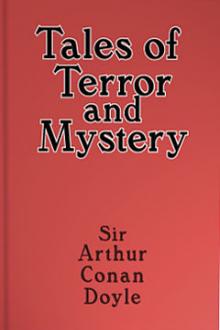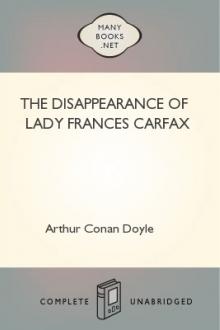Tales of Terror & Mystery, Arthur Conan Doyle [primary phonics .txt] 📗

- Author: Arthur Conan Doyle
- Performer: -
Book online «Tales of Terror & Mystery, Arthur Conan Doyle [primary phonics .txt] 📗». Author Arthur Conan Doyle
John Palmer, the guard was able at the inquest to give some evidence which threw a little light upon the matter. There was a spot between Tring and Cheddington, according to his statement, where, on account of some repairs to the line, the train had for a few minutes slowed down to a pace not exceeding eight or ten miles an hour. At that place it might be possible for a man, or even for an exceptionally active woman, to have left the train without serious injury. It was true that a gang of platelayers was there, and that they had seen nothing, but it was their custom to stand in the middle between the metals, and the open carriage door was upon the far side, so that it was conceivable that someone might have alighted unseen, as the darkness would by that time be drawing in. A steep embankment would instantly screen anyone who sprang out from the observation of the navvies.
The guard also deposed that there was a good deal of movement upon the platform at Willesden Junction, and that though it was certain that no one had either joined or left the train there, it was still quite possible that some of the passengers might have changed unseen from one compartment to another. It was by no means uncommon for a gentleman to finish his cigar in a smoking carriage and then to change to a clearer atmosphere. Supposing that the man with the black beard had done so at Willesden (and the half-smoked cigar upon the floor seemed to favour the supposition), he would naturally go into the nearest section, which would bring him into the company of the two other actors in this drama. Thus the first stage of the affair might be surmised without any great breach of probability. But what the second stage had been, or how the final one had been arrived at, neither the guard nor the experienced detective officers could suggest.
A careful examination of the line between Willesden and Rugby resulted in one discovery which might or might not have a bearing upon the tragedy. Near Tring, at the very place where the train slowed down, there was found at the bottom of the embankment a small pocket Testament, very shabby and worn. It was printed by the Bible Society of London, and bore an inscription: “From John to Alice. Jan. 13th, 1856,” upon the fly-leaf. Underneath was written: “James. July 4th, 1859,” and beneath that again: “Edward. Nov. 1st, 1869,” all the entries being in the same handwriting. This was the only clue, if it could be called a clue, which the police obtained, and the coroner’s verdict of “Murder by a person or persons unknown” was the unsatisfactory ending of a singular case. Advertisement, rewards, and inquiries proved equally fruitless, and nothing could be found which was solid enough to form the basis for a profitable investigation.
It would be a mistake, however, to suppose that no theories were formed to account for the facts. On the contrary, the Press, both in England and in America, teemed with suggestions and suppositions, most of which were obviously absurd. The fact that the watches were of American make, and some peculiarities in connection with the gold stopping of his front tooth, appeared to indicate that the deceased was a citizen of the United States, though his linen, clothes and boots were undoubtedly of British manufacture. It was surmised, by some, that he was concealed under the seat, and that, being discovered, he was for some reason, possibly because he had overheard their guilty secrets, put to death by his fellow-passengers. When coupled with generalities as to the ferocity and cunning of anarchical and other secret societies, this theory sounded as plausible as any.
The fact that he should be without a ticket would be consistent with the idea of concealment, and it was well known that women played a prominent part in the Nihilistic propaganda. On the other hand, it was clear, from the guard’s statement, that the man must have been hidden there BEFORE the others arrived, and how unlikely the coincidence that conspirators should stray exactly into the very compartment in which a spy was already concealed! Besides, this explanation ignored the man in the smoking carriage, and gave no reason at all for his simultaneous disappearance. The police had little difficulty in showing that such a theory would not cover the facts, but they were unprepared in the absence of evidence to advance any alternative explanation.
There was a letter in the Daily Gazette, over the signature of a well-known criminal investigator, which gave rise to considerable discussion at the time. He had formed a hypothesis which had at least ingenuity to recommend it, and I cannot do better than append it in his own words.
“Whatever may be the truth,” said he, “it must depend upon some bizarre and rare combination of events, so we need have no hesitation in postulating such events in our explanation. In the absence of data we must abandon the analytic or scientific method of investigation, and must approach it in the synthetic fashion. In a word, instead of taking known events and deducing from them what has occurred, we must build up a fanciful explanation if it will only be consistent with known events. We can then test this explanation by any fresh facts which may arise. If they all fit into their places, the probability is that we are upon the right track, and with each fresh fact this probability increases in a geometrical progression until the evidence becomes final and convincing.
“Now, there is one most remarkable and suggestive fact which has not met with the attention which it deserves. There is a local train running through Harrow and King’s Langley, which is timed in such a way that the express must have overtaken it at or about the period when it eased down its speed to eight miles an hour on account of the repairs of the line. The two trains would at that time be travelling in the same direction at a similar rate of speed and upon parallel lines. It is within every one’s experience how, under such circumstances, the occupant of each carriage can see very plainly the passengers in the other carriages opposite to him. The lamps of the express had been lit at Willesden, so that each compartment was brightly illuminated, and most visible to an observer from outside.
“Now, the sequence of events as I reconstruct them would be after this fashion. This young man with the abnormal number of watches was alone in the carriage of the slow train. His ticket, with his papers and gloves and other things, was, we will suppose, on the seat beside him. He was probably an American, and also probably a man of weak intellect. The excessive wearing of jewellery is an early symptom in some forms of mania.
“As he sat watching the carriages of the express which were (on account of the state of the line) going at the same pace as himself, he suddenly saw some people in it whom he knew. We will suppose for the sake of our theory that these people were a woman whom he loved and a man whom he hated—and who in return hated him. The young man was excitable and impulsive. He opened the door of his carriage, stepped from the footboard of the local train to the footboard of the express, opened the other door, and made his way into the presence of these two people. The feat (on the supposition that the trains were going at the same pace) is by no means so perilous as it might appear.
“Having now got our young man, without his ticket, into the carriage in which the elder man and the young woman are travelling, it is not difficult to imagine that a violent scene ensued. It is possible that the pair were also Americans, which is the more probable as the man carried a weapon—an unusual thing in England. If our supposition of incipient mania is correct, the young man is likely to have assaulted the other. As the upshot of the quarrel the elder man shot the intruder, and then made his escape from the carriage, taking the young lady with him. We will suppose that all this happened very rapidly, and that the train was still going at so slow a pace that it was not difficult for them to leave it. A woman might leave a train going at eight miles an hour. As a matter of fact, we know that this woman DID do so.
“And now we have to fit in the man in the smoking carriage. Presuming that we have, up to this point, reconstructed the tragedy correctly, we shall find nothing in this other man to cause us to reconsider our conclusions. According to my theory, this man saw the young fellow cross from one train to the other, saw him open the door, heard the pistol-shot, saw the two fugitives spring out on to the line, realized that murder had been done, and sprang out himself in pursuit. Why he has never been heard of since—whether he met his own death in the pursuit, or whether, as is more likely, he was made to realize that it was not a case for his interference—is a detail which we have at present no means of explaining. I acknowledge that there are some difficulties in the way. At first sight, it might seem improbable that at such a moment a murderer would burden himself in his flight with a brown leather bag. My answer is that he was well aware that if the bag were found his identity would be established. It was absolutely necessary for him to take it with him. My theory stands or falls upon one point, and I call upon the railway company to make strict inquiry as to whether a ticket was found unclaimed in the local train through Harrow and King’s Langley upon the 18th of March. If such a ticket were found my case is proved. If not, my theory may still be the correct one, for it is conceivable either that he travelled without a ticket or that his ticket was lost.”
To this elaborate and plausible hypothesis the answer of the police and of the company was, first, that no such ticket was found; secondly, that the slow train would never run parallel to the express; and, thirdly, that the local train had been stationary in King’s Langley Station when the express, going at fifty miles an hour, had flashed past it. So perished the only satisfying explanation, and five years have elapsed without supplying a new one. Now, at last, there comes a statement which covers all the facts, and which must be regarded as authentic. It took the shape of a letter dated from New York, and addressed to the same criminal investigator whose theory I have quoted. It is given here in extenso, with the exception of the two opening paragraphs, which are personal in their nature:
“You’ll excuse me if





Comments (0)